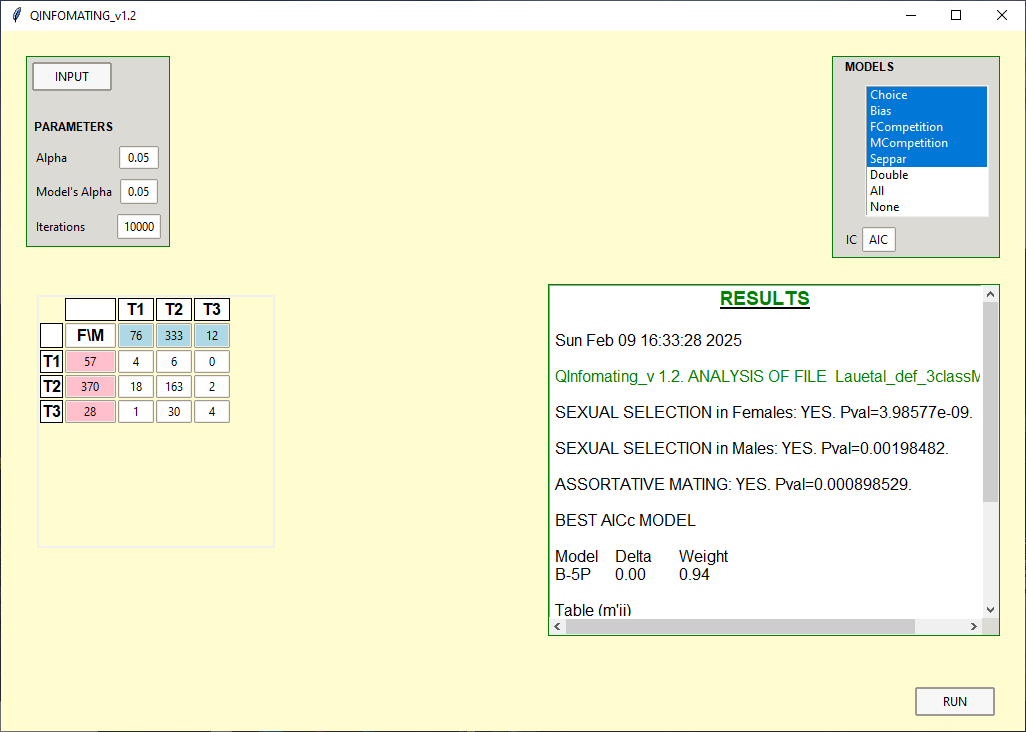
QInfoMating: Sexual selection and assortative mating estimation
Citation
If you use the QInfomating program, please cite:
Carvajal-Rodríguez, A. 2025. QInfoMating: Sexual Selection and Assortative Mating Estimation Software. BMC Ecology and Evolution 25 (51). DOI: 10.1186/s12862-025-02394-8.
Carvajal-Rodríguez, A. 2024. Unifying quantification methods for sexual selection and assortative mating using information theory. Theoretical Population Biology 158: 206-215. DOI: 10.1016/j.tpb.2024.06.007.
For discrete data:
Carvajal-Rodríguez, A. 2020. Multi-model inference of non-random mating from an information theoretic approach. Theoretical Population Biology 131: 38-53. DOI: 10.1016/j.tpb.2019.11.002. The preprint has been recommended by PCI EvolBiol.
Carvajal-Rodríguez, A., 2018. Non-random mating and information theory. Theoretical Population Biology 120, 103-113. DOI: 10.1016/j.tpb.2018.01.003.
Carvajal-Rodríguez, A. 2025. QInfoMating: Sexual Selection and Assortative Mating Estimation Software. BMC Ecology and Evolution 25 (51). DOI: 10.1186/s12862-025-02394-8.
References
References for program methods are, for continuous data:
Carvajal-Rodríguez, A. 2024. Unifying quantification methods for sexual selection and assortative mating using information theory. Theoretical Population Biology 158: 206-215. DOI: 10.1016/j.tpb.2024.06.007.
For discrete data:
Carvajal-Rodríguez, A. 2020. Multi-model inference of non-random mating from an information theoretic approach. Theoretical Population Biology 131: 38-53. DOI: 10.1016/j.tpb.2019.11.002. The preprint has been recommended by PCI EvolBiol.
Carvajal-Rodríguez, A., 2018. Non-random mating and information theory. Theoretical Population Biology 120, 103-113. DOI: 10.1016/j.tpb.2018.01.003.
Contact
For any questions about the options of the program you can contact me
Disclaimer
This program is free software; you can redistribute it and/or modify it under the terms of the GNU General Public License as
published by the Free Software Foundation; either version 2 of the License, or (at your option) any later version. This program
is distributed in the hope that it will be useful, but WITHOUT ANY WARRANTY; without even the implied warranty of
MERCHANTABILITY or FITNESS FOR A PARTICULAR PURPOSE. See the GNU General
Public License for more details. You should have received a copy of the GNU General Public License along with this
program; if not, write to the Free Software Foundation, Inc., 59 Temple Place - Suite 330, Boston, MA 02111-1307, USA.
See the file "gpl.html" under the "license" directory.
Return to AC-R home
Introduction
The QInfomating methodology is based on information theory. The same information divergence measures when applied to discrete or continuous data produce different statistics that allow the detection of sexual selection and assortative mating.
The program allows you to read continuous or discrete data and performs tests for sexual selection and assortative mating. It then calculates the best fit model and applies multi-model inference techniques to estimate the values of the parameters. For continuous data, it only performs model selection if either test is significant, then calculates the frequency distribution (classes) for the continuous data, and then proceeds to multi-model estimation.
Please refer to the program manual for detailed explanations.
The program allows you to read continuous or discrete data and performs tests for sexual selection and assortative mating. It then calculates the best fit model and applies multi-model inference techniques to estimate the values of the parameters. For continuous data, it only performs model selection if either test is significant, then calculates the frequency distribution (classes) for the continuous data, and then proceeds to multi-model estimation.
Please refer to the program manual for detailed explanations.

A. Carvajal-Rodriguez - Departamento de Bioquímica Genética e Inmunología - Universidad de Vigo.
( Last update: 10022025)